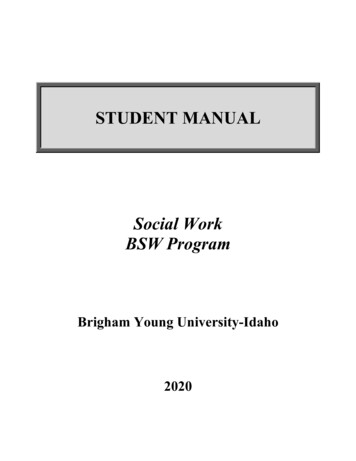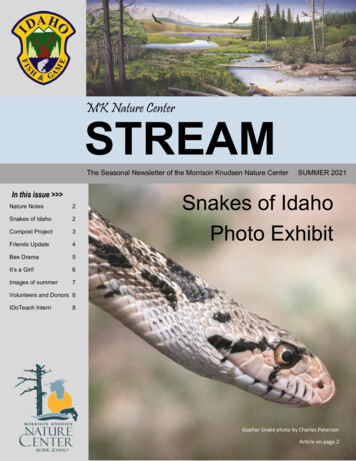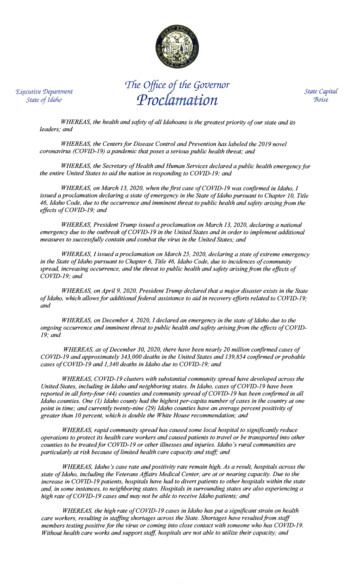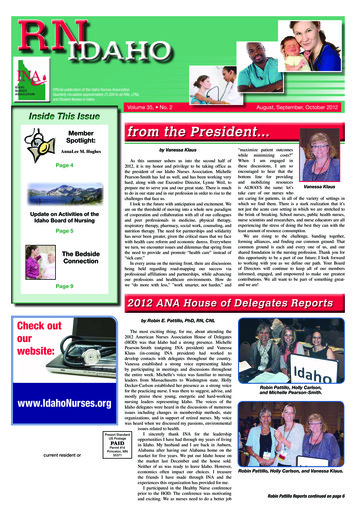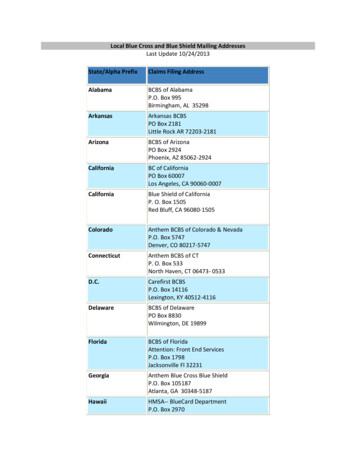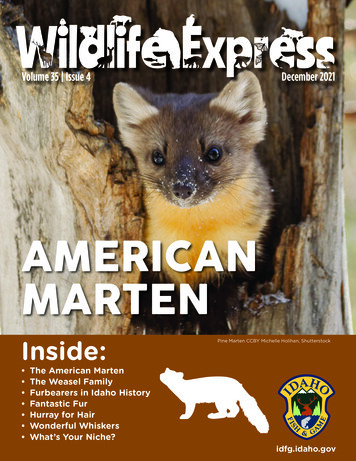
Transcription
Volume 35 Issue 4December 2021AMERICANMARTENInside: Pine Marten CCBY Michelle Holihan, ShutterstockThe American MartenThe Weasel FamilyFurbearers in Idaho HistoryFantastic FurHurray for HairWonderful WhiskersWhat’s Your Niche?idfg.idaho.gov
the American MartenCute is one of the best words to describeAmerican martens! They look a bit like a small,slender house cat with a long, bushy tail.American martens are 18 to 26 inches long andweigh only one to three pounds. They have pointedfaces with big round ears. American martens’beautiful fur is brown to black in color and silkysoft. On their throats, they have a splash of colorthat is creamy white to orange.voles. They may ambush their prey or leap from a“hunting perch” in a tree. American martens alsoeat red squirrels, chipmunks, rabbits, insects, birds,eggs, fruits and berries.You may hear people call American martens,pine martens because they live in dense forests.American martens are excellent tree climbers. Theyhave semi-retractable claws similar to a cat. Withtheir claws and long tail for balance, Americanmartens can zip up a tree and leap between treesquickly and easily. In Idaho, they are found inconifer forests. A forest floor covered with fallenlogs, stumps and shrubs makes the best habitat.The trees on the ground are the perfect place tofind shelter and food.American martens are animals that like to livealone. The only time American martens are seentogether is during the breeding season or whenmothers have young. Marten babies, called kits,are born in March or April. The mother chooses ahole in a tree or similar cozy spot to have her kits.Between one to five kits are born. The young arehelpless, blind and tiny when born. They weigh onlyas much as three crayons! Kits may be small whenborn, but they grow quickly drinking their mother’smilk. For the first six weeks of their lives, the kitsare nursed by their mother. When the kits are sixto seven weeks old, the mother will start to weanthem and bring them meat to eat. By the time thekits are three months old, they are nearly fullgrown and able to live on their own.What do American martens eat? They mostly eatvoles. Voles are small rodents that look like mice.Martens run around on the forest floor poking theirheads into holes, fallen logs and rocks looking forNext time you are in an Idaho forest, don’t forget tolook up. You may be lucky enough to see a curiousAmerican marten looking back at you. You mayeven see it leaping and jumping from tree to tree!Pine Marten CCBY IDFG
TheWeaselFamilyMembers of the weasel family are calledmustelids (mus-TELL-ids). In Latin, “mustela”means weasel. This group of animals includeswolverine, badger, fisher, weasels, Americanmarten, mink, and otters. In Idaho, we have eightspecies of mustelids.Mustelids are found on every continent exceptAntarctica and Australia. They range in size fromthe sea otter that can weigh as much as a thirdgrader to the least weasel, which weighs aboutthe same as two pinkie erasers.Wolverines are the largest mustelidin Idaho; they usually weighbetween 20 to 40 pounds. Shorttailed weasels are the smallest. Theyare eight to 14 inches long and weightwo to seven ounces.Most mustelids have long, slenderbodies and short legs. Their shapehelps them to more easily getinto tight spaces or move throughthe water. Even the bulky-lookingbadger and wolverine are amazinglyflexible and quick. Several species,including the marten and fisher, areexcellent climbers. The otters andmink are wonderful swimmers andspend a lot of time in the water.The long, thin shape of mustelidsmakes it difficult tostay warm andPhotos left to right: Weasel CCBY Tony Gray,Flickr, River Otter CCBY Marnee Jill, Flickrstore fat, so they eat a lot. As a family, mustelidsare mainly carnivores. They eat other animals, butthey may also eat fruits, berries or plants. When amustelid kills more than it can eat at one sitting, itsaves the rest for another meal. The leftovers arehidden in a place called a “cache” (cash). Whenthe animal is hungry, it will return to the cache andfinish eating its catch.All members of the weasel family have somethingin common. They stink! Mustelids have glandslocated at the base of the tail that make musk.Musk is a strongly scented liquid. It may be used toattract a mate or to mark their homes or territories.The smell tells other members of the same speciesto stay out! Some mustelids mark their cacheswith musk. By doing this, they are warning othersto stay away from their food. The smell also helpsthem locate the cache later.Keep an eye out formustelids whileenjoying time inIdaho’s forests.These active,curious and strongcreatures can be veryentertaining to watch!
FurbearersinIdaho HistoryBeaver Fur CCBY cloudtail, FlickrFurbearers are animals that are trapped orhunted for their fur. Furbearers are the reasonEuropean people first came to this area.animals in the area. Mountain men that were notmembers of fur companies were also trappinganimals.In the early 1800s, furs were used to make coats,hats, gloves and other pieces of clothing. TheAmerican marten was called the American sable inEurope. The sable is closely related to our marten.Sable fur was worn only by royalty and nobles.As sables became harder to find, people trappedAmerican martens and shipped them to Europe touse in place of sables.Beaver trapping had a huge impact on Idahohistory. Beaver hats were very popular; every manwanted one. Soon beavers were harder to findin the Eastern United States and Canada. Thisbrought trappers to what we now call Idaho.Many countries wanted the riches of this land forthemselves. Great Britain operated The Hudson’sBay Fur Company. They wanted to keep Americansfrom expanding westward to claim the land. Theirsolution was to create a “fur desert” to keep theAmericans out of the area. They thought that ifthey trapped all the beavers, no Americans wouldwant to live here. Between 1818 and 1827, theytrapped 85,000 beavers out of the Snake Riveralone! Now that is a lot of beavers. Trapping all ofthose beavers didn’t keep Americans out of thearea. Russia gave the Northwest Territory, whichincluded Idaho, to the United States in 1824.In 1809, David Thompson built Kullyspell Houseby Lake Pend Oreille. This was the first Europeanbuilding constructed in Idaho. The house wasbuilt for the Northwest Fur Company. Soon othertrappers heard about all the beavers in the area. By1811, four furcompaniesweretrappingbeaversand otherPioneers and homesteaders also trapped animals.Trapping was one way to feed a family and earnmoney. Some animals, especially beavers, werebecoming hard to find. Too many beavers werebeing trapped. Some people thought beaversneeded protection. In 1899, a law was passedthat protected beavers from being trapped orhunted. The law helped and beavers becomemore common. In 1957, people were once againallowed to trap beavers. With proper laws andmanagement, Idaho will always have furbearers.Beaver PeltchivesCCBY The US National ArKullyspell HouseCCBY John Bish, Barren Magazine
ruFcitsatnaFMany animals are covered by what is calledfur. You know what fur looks like. Martens,bears and coyotes are all covered by fur. Itlooks like long, soft hair. However, there ismore to fur than meets the eye.Fur is made up of two different layers of hairs.Guard hairs make up the top layer. These hairsdo just what their name says. They guard andprotect the animal’s second layer of fur andskin from weather and water. Often guard hairsare shiny, because animals put oil on them.Animals that spend a lot of time in water, likebeavers and otters, don’t want their fur andskin to get wet. They might get too cold if theygot wet. Water hits the oily guard hairs andruns off the animals’ backs, keeping their furdry.is usually very soft and fluffy. It helps keepanimals warm. Animals fluff up their underfurand trap air in it. The animals’ bodies warmthe trapped air. The warmed air acts likeinsulation, and the animals stay nice and cozy.This is what happens when you put on a coat.Your body heats the air trapped by the coat,and you stay warmer.Some animals, like beavers, have specialglands that make oil just for spreading on theirfur. Beaver oil glands are at the base of theirtail. Other animals have very small oil glandsall over their skin to help keep the guard hairsoily.Some animals with fur also have other specialhairs on their bodies. Can you think of any?Porcupines may come to mind. Porcupineshave quills in their fur. The quills are specialhard hairs that protect porcupines from theirenemies. When danger is near, porcupineswill arch their backs and tuck their headsunder their bodies. This makes the quills stickstraight up in the air. If an animal tries totouch the porcupine, it will get a quill in itsbody. Porcupines cannot shoot quills out oftheir bodies, as some people may have heard.Remember, a quill is just a hair. You can’t shoothairs out of your head, so porcupines can’tshoot quills out of their bodies.The second layer of fur is called underfur.It is shorter than the guard hairs. UnderfurFur is a fantastic way for animals to stay warmduring the cold winter!Photos left to right, top to bottom: Grizzly Bear Fur CCBY Michael Fraley, Flickr, Porcupine QuillsCCBY IDFG, Coyote Fur CCBY T. Thomas, River Otter CCBY Ryan Grewell, Unsplashed
riaHrofyarrHuSome animals have hair on their bodiesinstead of fur. Fur is made of two differentlayers of hairs. Hair is usually just one layer,and all the hairs look alike. Hairs are usuallythick and stiff. Deer and elk have hair, so doyou!If you looked closely at a deer hair, you wouldsee that it looks a bit like a straw. The hair ishollow. Animals with fur trap air to stay warm.Well, so do animals with hair. When they arecold, they stick their hairs up. They trap airinside and in between all of their hairs. The airtrapped in the hair and in between the hairmakes a nice coat of insulation against thecold.If you ever get goosebumps look at the bumpson your arm. You will see a hair sticking up inthe middle of the bumps. Your body gets coldand tries to trap air by making your hair standup. We are not very good at trapping air in ourhair. Our hairs are too thin and short to trapair.Many animals grow a thicker layer of hair forthe winter. More hair means they can trapmore air and stay warmer. Some animals withhair grow a thick woolly layer of special hairclose to their skin. Caribou do this. The woollylayer of hair is similar to the underfur thatanimals with fur have. In the winter, caribouare out in temperatures that can get down to60 degrees below zero! Now that’s cold. Theirwoolly layer of hair insulates them from thecold and helps to block the icy wind.In the spring, animals will shed their winterhair and grow thinner summer coats. Animalsoften look shaggy and strange when they areshedding their long winter coats. People mayeven think an animal is sick. Once the silkysummer hairs grow back, the animal will lookgood again.Photos left to right, top to bottom: Caribou Fur CCBY Bob Wick, Flickr, Mule Deer CCBY LorraineLogan, Shutterstock, Elk CCBY IDFG, White-tailed Deer CCBY Roger Phillips
You’re walking along a trail. All of asudden, you see something grayishwhite peeking out of the tall grass. Leaningforward, you realize what it is – a skull. Nowthe mystery really begins. What animal didthat skull belong to, and how did it live itslife?This may be a hard question to answer, butthe skull will give you some clues. One ofthe best clues you have is the teeth. Teethtell you what an animal eats. Animals thateat meat need teeth that will help them cutand tear. Meat eaters, called carnivores, havemeat-cutting teeth along their cheeks. Theseteeth are sharp and pointed. When the topteeth and the bottom teeth come together,the teeth pass each other like scissors.Martens have no trouble slicing through amouse with their teeth!Sharp pointed teeth may work well for meateaters, but they sure wouldn’t help planteaters. Plant eaters are called herbivores. Ittakes a lot of chewing to break down plants.Just think how long you need to chewcelery! Herbivores have tall teeth in the backof their mouths with flat tops. Flat teeth letthe animals slide their top and bottom teethagainst each other and grind plants.We have teeth in the back of our mouthswith low bumpy crowns, so do bears.Teeth with this shape belong to omnivores.Omnivores eat both meat and plants, sothey need teeth that help cut and grind.WHAT’STHAT?Skull in the woods CCBY englepip, FlickrThe location of the eye sockets on the skullcan also tell you a lot. Predators, animalsthat eat other animals, need to be able totell distances. This comes in handy whenreaching out to grab a mouse. Predatorshave eyes that face forward. Prey animals,animals that other animals eat, have theireyes located more to the sides of theirheads. This lets them be on the lookout fordanger in almost every direction withoutever moving their heads.Looking at these clues may not tell you whatanimal the skull came from, but it is a start.It may give you an idea of what the animaleats and whether it is a predator or preyanimal.
Wonderful WhiskersAmerican martens have whiskers on their facesthat help them while hunting. Other animalsdepend on whiskers, as well.Imagine you are an animal hunting during a dark,moonless night. Your eyes, although designed towork in low light, are having a difficult time seeing.You are hungry, and you know a mouse must benearby. How are you going to find the mouse ifyou can’t see it? Use your whiskers to feel thevibrations caused by the mouse moving.Whiskers are great tools for animals that hunt atnight or in dark places. Whiskers are special hairsthat are very sensitive to touch and movement. Allmammals, except humans, have whiskers. Althoughmen’s beards are called whiskers, they are justbody hairs. Animal whiskers are different than thewhiskers on a man’s beard.Whiskers are called vibrissae (vy-BRISS-ee). Theyare thicker and rooted deeper in the skin thanregular hairs. When something touches a whisker,the information goes down the hair to the nerves.The nerves tell the brain what the whiskers havefelt.Whiskers not only grow on animals’ faces. Cats,foxes and squirrels have whiskers on their ankles.Some bats have them on their rumps, andunderground burrowers, like moles, have whiskersbehind their ears and on their tails and front feet.Flying squirrels use whiskers on their heads, feetand legs to help them find their way through treesat night.Sometimes animals use whiskers to greet. Whentwo rats meet, they rub their whiskers over eachother. This helps them to identify the other rat.Mammals would have a difficult time gettingaround and catching food without their whiskers.Whiskers help animals stay in touch with theirenvironment.Photos left to right, top to bottom: Pine Marten CCBY Yankech Gary, Flickr, Flying SquirrelCCBY Judy Gallagher, Flickr, Mole CCBY Link576, Flickr, Rats CCBY S.J. Pyrotchnic
TWhat’s yourNiche?hink of the town where you live. People inyour community have jobs that make it anice place to live. There are doctors that keepyou healthy. Teachers that help you learn, andpeople that produce food for you to eat.Animals, plants and other organisms also havejobs and roles to play where they live. Thisrole is called a niche (NICH). An animal’s nicheincludes such things as where and how theanimal gathers food and its link in a food chain.American martens eat many rodents and helpkeep rodent populations from growing too large.Within ecosystems, every living thing has animportant job and role. If one of these organismsis missing, the ecosystem will be unhealthy. Attimes, it may be hard to see an animal’s niche.What about skunks? They just seem like stinkyanimals that cause problems. Even the smellyskunk has a role in nature. Skunks eat moreinsects than anything else. They really love toeat grasshoppers, beetles and moth larvae. Manyinsects that skunks eat like to munch on farmers’crops. Skunks help farmers by eating crop pests.The small bit of grass or soil they dig up lookingfor food is a small price to pay for all the insectsthey eat.What’s your niche? Do you have an importantjob or role to play in your family or school?Photos top to bottom: Grasshopper CCBY Alan Harper, Flickr, Skunk CCBY ClydeNishimura, Flickr, Idaho Scenic CCBY Carol Jacob Carre, Flickr
Winter is a wonderfultime to explore theoutdoors! A blanket of newsnow makes familiar placeslook quite different. Noisy streams become silentunder ice and snow. Animals that you rarely see,like many furbearers, can now be “seen” whenyou find their tracks in the snow. Cold nips yourcheeks and makes you look forward to a cup ofhot chocolate after being outside.Winter activities are many. Skiing and skating aregreat ways to enjoy winter. So are sledding andsnowshoeing. If you do not have any equipment,you can still enjoy winter by just taking awalk in the snow. Build a snow fort with yourfriends or decorate your yard with snowmen. Ifit is snowing, catch some snowflakes on yourmittens and use a magnifying glass to look atthe beautiful crystals. Take a walk in new snowto see what animal tracks you can find. Look forbird nests in the trees. If you live near a river orlake, do some winter bird watching to look forbald eagles and ducks. Don’t forget to check outthe winter night sky. Cold, clear winter nightsPhotos left to right, background: deer tracks CCBY cherrysweetdeal, Flickr,sledding CCBY Christian M. Brady, Flickr, Idaho Scenic CCBY A. Davey, Flickrcan give you some great opportunities to seethe stars.If you find a set of animal tracks, take a closelook. Does the animal have hoof prints like adeer or footprints like a raccoon? Can you tellwhat direction the animal was going and howfast? Do the tracks go in one direction or dothey wander around? Maybe the tracks suddenlyend up disappearing under the snow. Followinganimal tracks in the snow is a fun way to learnabout your wild neighbors.No matter what kind of winter activity you enjoy,dressing properly is very important. Wear layersthat you can take off when you warm up and putback on if you feel cold. Snow pants can helpyou stay warm and dry. Warm boots are veryimportant for winter fun. Don’t forget a hat andmittens! Wearing a hat is one of the best waysto stay warm, no matter what you are doing. So,get into your winter clothes and head outsidefor some winter fun. After all, winter is a big partof every year in Idaho!
Marvelous American cheVoleWeaselWhiskersAcross2. Vibrissae is the fancy word for .4. Martens use this to scent mark their territories.8. This is an animal that eats meat.9. American martens are members of the family.Down1. The word used to describe an animal's job in its environment.3. Furbearers have played an important role in Idaho's .5. This animal makes up most of the American marten's diet.6. Baby martens are called .7. American martens like to live in dense .8. Martens have semi-retractable that help them climb trees.Volume 35 Issue 4 American Marten December 2021Wildlife Express is published by the IdahoDepartment of Fish and GameEditor: Adare EvansLead Writer: Adare EvansLayout: Glenna GomezContributors: Adare Evans, Lori Adams,Vicky RunnoeWE WOULD LIKE TO HEAR FROM YOU!If you have a letter, poem or question for Wildlife Express,it may be included in a future issue! Send it to:adare.evans@idfg.idaho.govorWildlife Express, Idaho Fish and GamePO Box 25, Boise, ID 83707
American martens are excellent tree climbers. They have semi-retractable claws similar to a cat. With their claws and long tail for balance, American martens can zip up a tree and leap between trees quickly and easily. In Idaho, they are found in conifer forests. A forest floor covered wi



